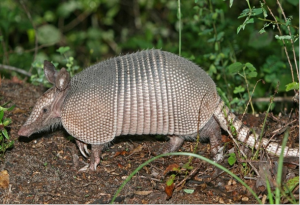by
Dan Rayfield, Texas Master Naturalist, Indian Trail Chapter
Think with me for a minute about images associated with Texas. What comes to mind? Sure, there are some obvious ones: oil wells, longhorn cattle, and cowboys on paint horses to name a few; but what about the armadillo? Many people do seem to associate the odd looking and oddly appealing little creature with the great state of Texas. In point of fact, the nine banded armadillo (Dasypus novemcinctus) is the official “small mammal” of Texas.
During my growing up years (which is longer ago than I care to admit) armadillos were always around. This led me to believe that they had always been a part of the Texas landscape. Not so. Armadillos first crossed the Rio Grande into Texas in the late 1800’s. An old natural history book we have that was published in the 1950s states that the armadillos then current range was south of an east/west line near Corpus Christi. Today armadillos extend as far north as southern Nebraska. Wildlife biologists believe they will continue to expand their range until they reach areas with harsher winters. The armadillos’ lack of fur and relative lack of insulating body fat make winter survival a problem.
Even though the digging is not easy on the caliche rock of my ranch, we do have several armadillos around. That gives us a chance to closely observe them. I call this “master naturalist research” while more motivated folks might call it “goofing off”. Whatever it is called, we observed two armadillo behaviors recently that we had never seen before. The first occurred after the recent rain we had. At a low point on what we euphemistically call a road from our gate to our house there was a large chug hole of standing water and mud. As we came home one day, we noticed it was moving. Pausing to watch we saw an armadillo blissfully rolling and playing in the mud hole. Now armadillos have great senses of smell but they can’t see very well at all. When we had to move on, I tapped the horn and you would have thought he had touched an electric fence. With a high jump and 180-degree-turn in mid-air, he was back in the brush. (I gave him a “10” for distance and a “9.5” for style points.)
The second interesting behavior occurred when my bride noticed an armadillo near our back deck behaving oddly. She (we think the behavior indicated female) was sort of half hopping backwards along a planting area toward the deck. Was she sick, we wondered? As she got closer to us we noticed that she had accumulated a pile of leaves and a blue piece of plastic. She was holding on to her treasures with her front feet and appeared to be backing to where we suspect she had her burrow under the deck. Grabbing the ’50s-era natural history book, we saw that fall is breeding season and that females do line their burrows. Mystery solved.
To close, let me give you two more armadillo reproduction facts that you can casually drop during conversation to impress your friends. Fact # 1 – After mating, the fertilized armadillo egg does not begin to immediately gestate. That does not happen for approximately fourteen weeks and the babies are born in the spring. Fact # 2 – When it does begin to gestate the single egg divides into four identical quadruplets. So when you see an armadillo and her four babies you can casually point out to folks nearby that each baby is genetically identical. Armed with these facts you will be the hit of the party. I guarantee it.
If you are passionate about nature and enjoy learning, consider joining the Indian Trail Master Naturalists. Check out our website (http://txmn.org/indiantrail/) for meetings and information. We would love to have you.



